Introduction
DCC conducted acoustical testing at Urban Outfitter's (UO) new Fanueil Hall location in Boston. These acoustical tests, after the Noise Reduction (NR) tests performed in November 2004, were performed to determine the effects of using the Bose loudspeakers, as they would actually be installed in the store. The November tests were performed only in one location using two large EAW loudspeakers. Further, the November tests were performed before demolition of the interior walls.
Summary
The acoustical testing using the Bose loudspeakers shows far lower NR values than measured in November. Consequently, music played in the UO space at representative levels was clearly audible in many spaces adjacent to the UO space. One possible explanation for this change is the fact that all of the UO bays are now completely open, as opposed to the narrow corridor that was tested in November. Since these bays are very reflective, sound energy in these spaces is uniform and could have much more exposure to various gaps around perimeter walls and pipe and duct penetrations between floors. Another explanation could be dramatically varying floor thickness, but the gap theory is more likely. In some of the adjacent spaces, words from the music were clearly understandable which indicates that significant high-frequency energy is penetrating the floor. Usually that can only happen if there are openings or small gaps available for the sound to go through.
Acoustical Testing
Figure 1 shows a comparison of the NR measured in November versus January. The curve labeled 'NR UO/Offices' is the November measurements, and the curve labeled 'Music-based NR' is the January measurements after demolition. The January NR values are much lower than the November NR values. For comparison, the two other NR curves are of 2" plaster and 4" concrete which have surface weight similar to the current 2" thick concrete and 3/4" pine flooring. Those curves are similar to the original November NR measurements which further suggests that the November NR values match expected NR values for this type of construction, and the serious NR degradation of the current configuration is due to some anomaly such as cracks and gaps in the floor.
Figures 2 through 9 show measured music levels in adjacent spaces compared with ambient levels (no music). All of these figures show music levels higher than ambient levels at some frequencies. Music would have to be significantly lower than ambient levels at all frequencies to be inaudible.
A word of caution is warranted here with respect to Figure 1. The NR with music as the source is not likely the true NR that one would measure with a steady state pink noise source, because the exact timing of the music and exact duration of the measurement would have to be replicated upstairs and downstairs. However, the actual NR is probably close to the values shown in Figure 1.
Figure 10 shows the results of a test that was performed with the Bose loudspeakers mounted on the ceiling compared with the loudspeakers located on the floor. If the effect of room acoustics was removed, the measured music level should be lower with the loudspeaker on the floor versus mounted on the ceiling due to distance attenuation. However, Figure 10 shows that the level does not appreciably change with a change in speaker location. Vibrational energy transferred via the speaker mount should be much lower than that caused by the sound waves from the speaker. The hard and reflective surfaces in the room cause it to be highly reverberant and a uniform sound pressure field is excited almost irrespective of speaker location.
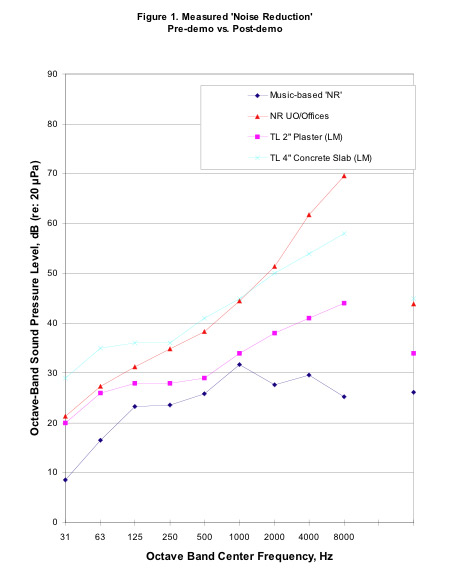
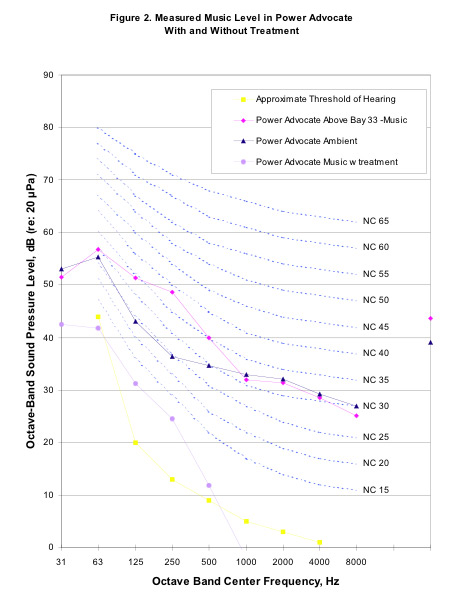
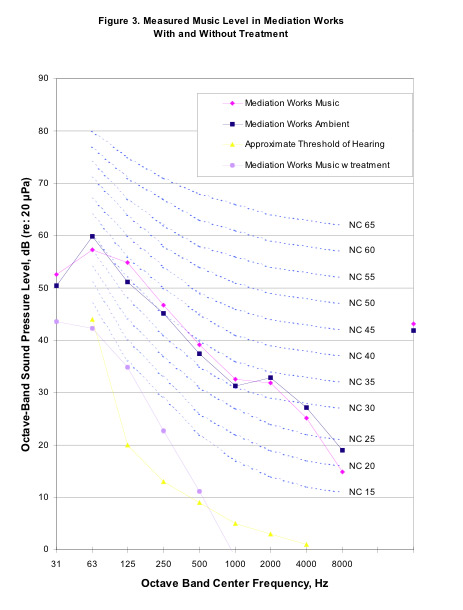
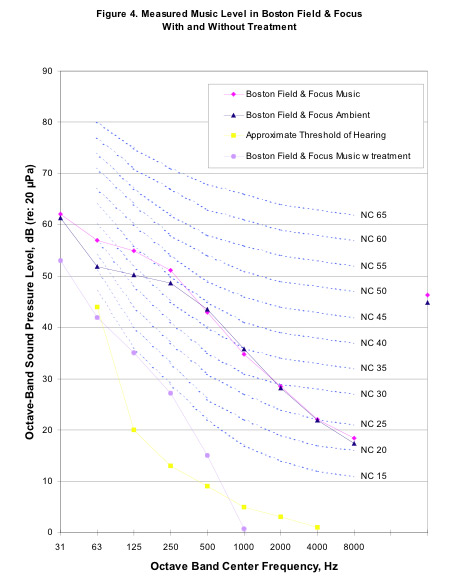
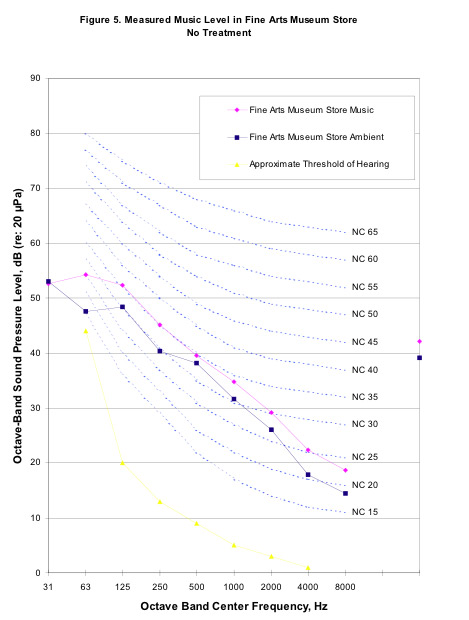
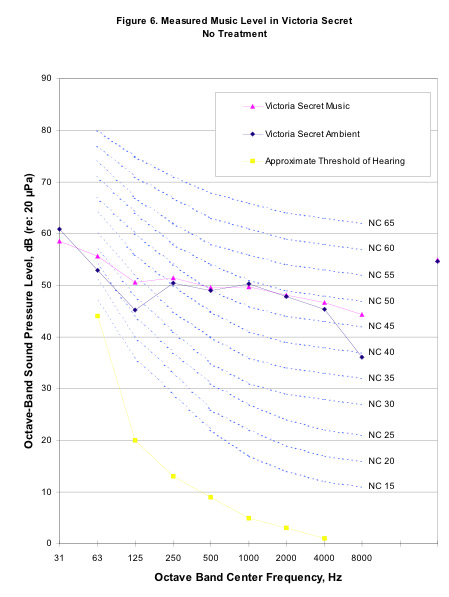
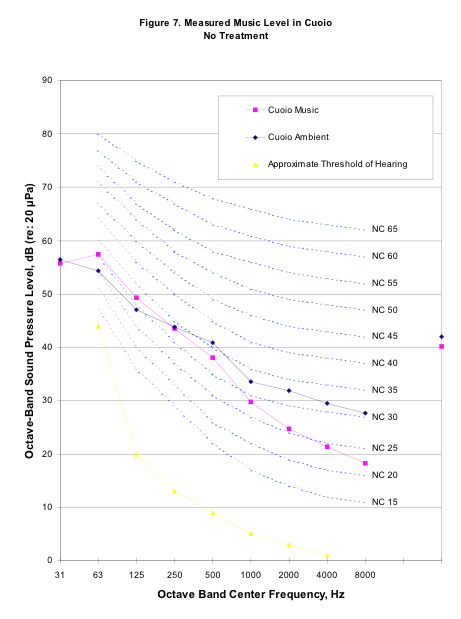
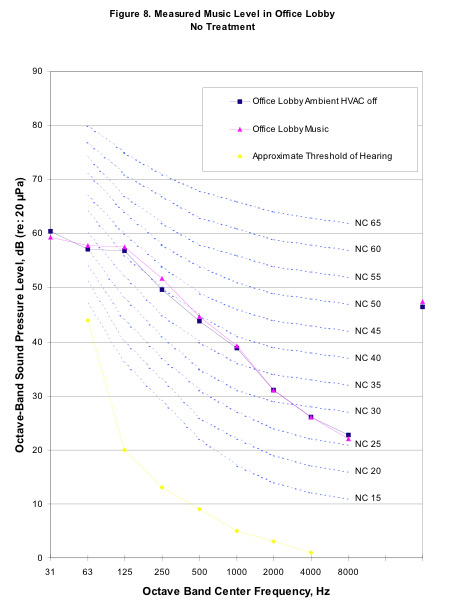
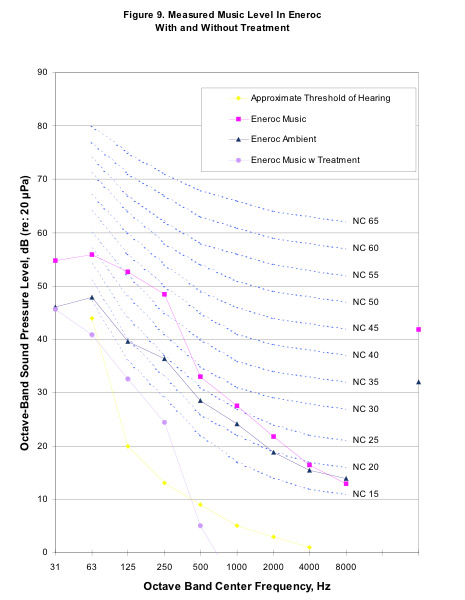
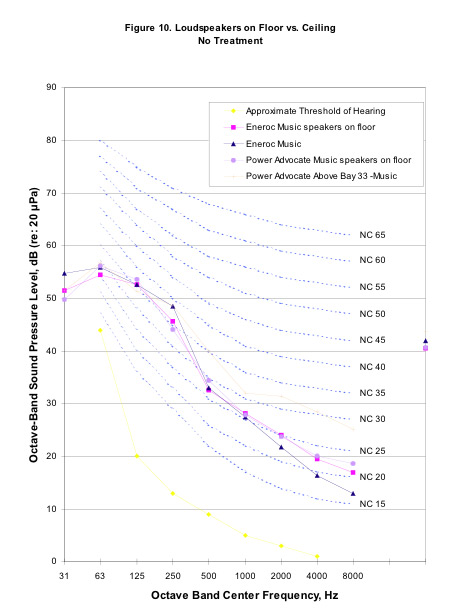
Sound Isolation Treatments
If the hypothesis that the floor has many gaps and penetrations that are causing low NR values is correct, then the first step is to completely seal all such leaks. I recommend that all significant gaps and penetrations be completely filled with a massive sealant such as cement grout. Very small gaps can be filled with a non-hardening caulk. It is a good practice to seal the larger gaps already filled with cement grout with caulk to completely seal off hairline cracks. Even very small cracks can defeat sound isolation treatments.
Given the serious nature of the NR performance degradation, I would also recommend that another sound test be performed after the sealing process to verify that NR values are closer to the November measurements. I also understand that you will conduct borings in the floor to verify its composition and thickness.
It is unlikely that a lightweight shotcrete product will have sufficient mass (if trowelled or sprayed on the ceiling) to provide significant NR improvement. A thicker and more massive slab (or floating slab) poured on the upstairs floor would have a much better chance of mitigating this sound. However, sound isolation treatments installed in adjacent spaces may not be an option.
At this point, I recommend 1" plywood (4 lb/ft^2) be resiliently mounted in the spaces between the trusses allowing for at least a 4" airspace. The airspace should be filled with 1" to 2" of fiberglass batt insulation to reduce cavity resonances. The perimeter of the plywood should be caulked with non-hardening caulk so all gaps are completely sealed. If the NR of the existing floor is improved to November levels, this sound isolation technique should result in acceptable music levels where the treatment is installed.
Duct penetrations through the floor could be a serious problem that could be identified during a sound test after the floor gaps are sealed. At minimum, loudspeakers should be located as far away as possible from these ducts. As discussed, duct silencers should be considered here. Duct silencers typically are designed in the design process of a HVAC system, and retrofit may be impractical here. Some other creative means of providing additional attenuation of sound through ducts will probably be needed in this situation.